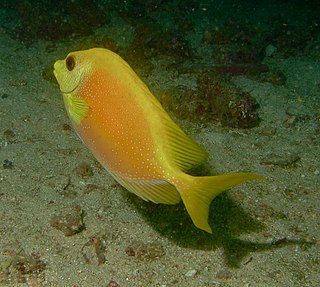
Pieter Bleeker was a Dutch medical doctor, ichthyologist, and herpetologist. He was famous for the Atlas Ichthyologique des Indes Orientales Néêrlandaises, his monumental work on the fishes of East Asia published between 1862 and 1877.

Chelmonops is a small genus of ray-finned fish, butterflyfishes from the family Chaetodontidae. Unlike the mainly tropical distribution of most marine butterflyfishes, Chelmonops is restricted to temperate and subtropical coastal waters along the southern half of Australia.

Kuiter's deepsea clingfish is a clingfish of the family Gobiesocidae, found only off southern Australia, at depths of between 90 and 110 metres.

Chaetodontoplus meridithii, the Queensland yellowtail angelfish, Meredith's angelfish or yellow-finned angelfish, yellowtail angelfish, is a species of marine ray-finned fish, a marine angelfish belonging to the family Pomacanthidae. It is found off eastern Australia.

Apolemichthys griffisi, or Griffis angelfish, is a species of ray-finned fish, a marine angelfish belonging to the family Pomacanthidae. It is found in the Pacific Ocean. It is a rarity for the species to enter the aquarium trade.

Ecsenius namiyei, commonly called black comb-tooth blenny or Namiye's coralblenny, is a species of marine fish in the family Blenniidae. The specific name honours the Japanese zoologist and museum curator Motoyoshi Namiye (1854-1915).

Ecsenius midas, known commonly as the Midas blenny, Persian blenny, lyretail blenny or golden blenny, is a species of marine fish in the family Blenniidae.

The blue-spotted spinefoot, the coral rabbitfish, coral spinefoot, ocellated spinefoot or orange spinefoot, is a species of marine ray-finned fish, a rabbitfish belonging to the family Siganidae. It is found in the Indo-Pacific where it is often caught as a food fish and occasionally as an aquarium fish.

Paraplesiops bleekeri, commonly known as the eastern blue devil, blue-tipped long-fin or Bleeker's blue devil fish, is a species of fish in the family Plesiopidae. This colourful, secretive fish is endemic to Australia, where it is a protected species.

Paraplesiops is a genus containing five largely allopatric species of fishes in the longfin, or roundhead, family Plesiopidae, commonly known as blue devils, bluedevils, or blue devilfish because of their colouration. The genus is most similar to the tropical genera Plesiops and Fraudella. It is restricted to subtropical and temperate rocky and coral reefs in Australian waters. Its species are mostly cryptic, occurring in submarine caves, crevices and under rocky ledges.

The western blue devil is a species of fish in the longfin family Plesiopidae endemic to Western Australia. The fish is found in rocky reef habitats in the coastal, inshore waters of southwestern Western Australia, from the Recherche Archipelago to Lancelin. The specific name was coined as a memorial to the ichthyologist Nicholas Sinclair of the Australian Museum who was involved in the collection of the type specimens.
The northern blue devil, Paraplesiops poweri, is a species of fish in the longfin family Plesiopidae. It has been recorded from the inshore waters of Queensland, eastern Australia, from Bowen to Moreton Bay. The specific name honours Percy Power, who caught the type specimen.
Peter Robert Last is an Australian ichthyologist, curator of the Australian National Fish Collection and a senior principal research scientist at CSIRO Marine and Atmospheric Research (CMAR) in Hobart, Tasmania. He is an elasmobranch expert and has described many new species of shark.
Gerald Robert "Gerry" Allen is an American-born Australian ichthyologist. His career began in 1963, when he spent a semester at the University of Hawaii, where he also received a PhD in marine zoology in 1971. In 1972, Allen wrote his doctoral thesis on the systematics and biology of the anemone fish.
John Ernest "Jack" Randall was an American ichthyologist and a leading authority on coral reef fishes. Randall described over 800 species and authored 11 books and over 900 scientific papers and popular articles. He spent most of his career working in Hawaii. He died in April 2020 at the age of 95.

Scorpaenopsis diabolus, the false stonefish, false scorpionfish or the devil scorpionfish, is a species of venomous marine ray-finned fish belonging to the family Scorpaenidae, the scorpionfishes. It has venomous spines and lives in the tropical Indian and Pacific Oceans as well as in the Red Sea. It is a bottom-dwelling predator that relies on its camouflage to catch passing prey.

Hemitaurichthys zoster, commonly known as the brown-and-white butterflyfish, black pyramid butterflyfish, zoster butterflyfish, or brushtooth butterflyfish, is a marine ray-finned fish, a butterflyfish belonging to the family Chaetodontidae native to the Indian Ocean.

Halicampus dunckeri or also commonly known as the Duncker's pipefish or ridgenose pipefish is a species of fish in the family Syngnathidae.
Helen K. Larson is an ichthyologist who specialises in the fishes of the Indo-Pacific.
Creedia haswelli, the slender sandburrower, is a species of marine ray-finned fish belonging to the family Creediidae, the sandburrowers. This species is found in Southern Australia. This species reaches a length of 7.5 cm (3.0 in).














